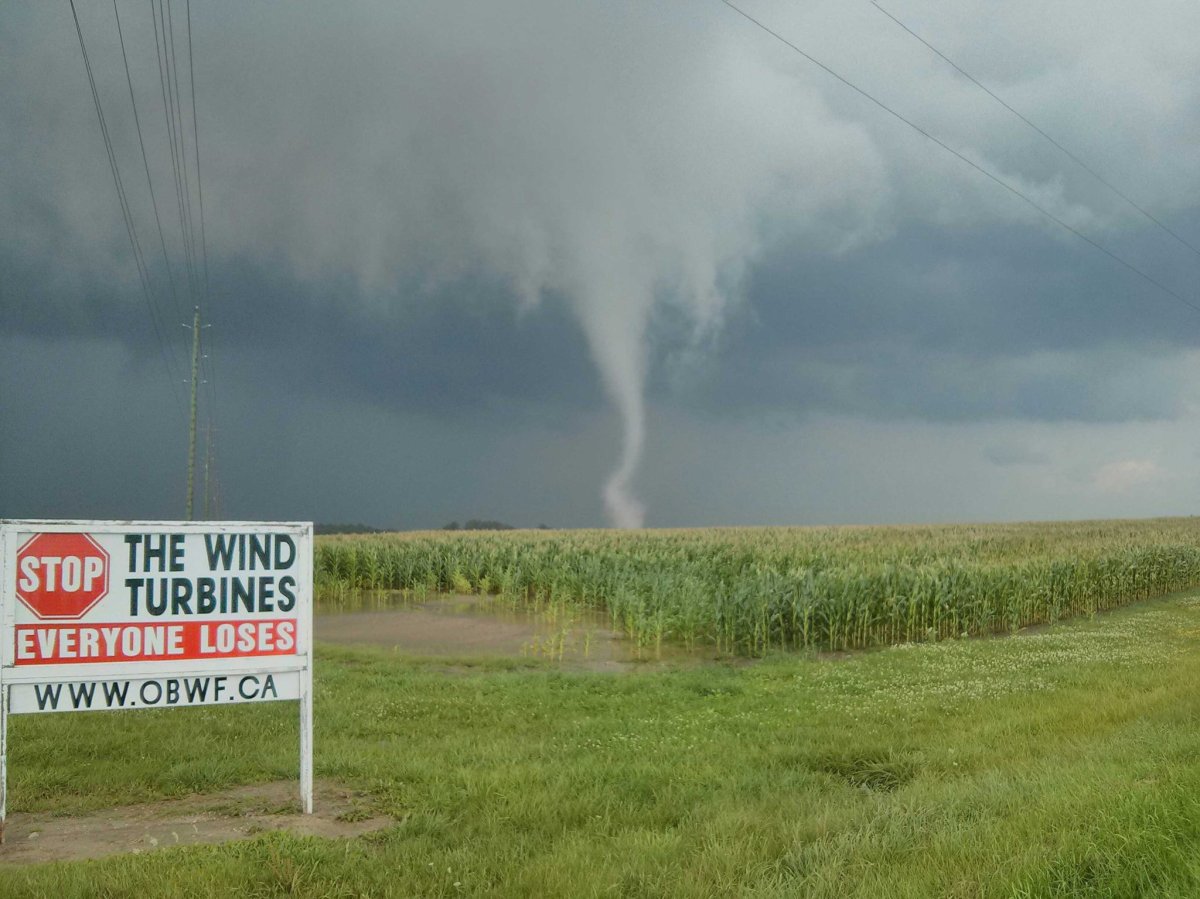TORONTO – When people think of Tornado Alley, they envision Oklahoma or Texas in the United States, with monster tornadoes bearing down on small towns and farms. They don’t envision southwestern Ontario. But they should.

Ontario – as well as the Prairies – has its own Tornado Alley, albeit a shadow of its larger cousin to the south.
READ MORE: A look at tornadoes in Canada
Since the 2014 storm season began – which typically runs from May to October – there have already been six tornadoes in Ontario (strangely, they all occurred – in pairs – on a Tuesday). The province typically sees about 17 tornadoes annually.
These 2014 tornadoes affected communities such as Angus, New Tecumseth and Amaranth.
Though tornado warnings were issued in almost all cases (severe thunderstorm warnings or tornado watches were issued in all other cases), many are asking how that information is disseminated to the public.
How watches and warnings are issued
Currently, Environment Canada issues a thunderstorm or tornado watch if it looks like there is a chance of severe weather. As storm systems develop, warnings are issued for areas where a severe thunderstorm or a tornado is occurring or where it appears to be imminent.
READ MORE: Is Canada experiencing more tornadoes?
Unlike the United States – in particular in areas of Tornado Alley – there are few places in Ontario that have a weather siren.
Instead, Environment Canada depends on two main ways to get that information to the public: a Weatheradio and the media.
Weatheradio is a network of radio transmitters that cover the U.S. and Canada. The device — which can come in a portable almost pocket-sized model — provides continuous weather information, but when a watch or warning is issued, it emits a loud warning sound and then follows with a voice statement pertaining to that particular advisory.
Coulson added that more than 90 per cent of the population is within range of a transmitter.

Get daily National news
High-tech society
Communities like Windsor, London and Sarnia lie right in the path of tornado alley, as warm moist air meets the cooler air and lake breezes of the Great Lakes. Of those communities only one – Sarnia – has a siren.
Emergency Management Ontario issues public alerts through various forms of social media, including Twitter and Facebook. It receives the warnings from Environment Canada.
The decision to install sirens falls to individual municipalities. But when those sirens go off – whether it’s for a severe thunderstorm or a tornado – varies across the country.
There are warning sirens at several universities in Ontario, including Western University in London and McMaster University in Hamilton. The Sarnia siren isn’t specific to weather, but is for disasters such as a toxic release or chemical spill.
John Carson, director of Campus Police at Western, told Global News that its siren system isn’t tied into Environment Canada or the city. Instead, the Environment Canada warnings are received by individual campus police officers who are on duty and can activate the siren.
Windsor, a city that frequently receives severe storms (it is the location of the deadliest tornado in the province’s history) has considered sirens, but as one of many options.
READ MORE: By the numbers – Ontario’s deadliest tornadoes
“It comes up from time to time, the idea of tornado sirens,” said Jason Moore, senior manager of communications and customer services for the City of Windsor. “We’ve never ruled it out specifically…but because of the maintenance and the cost of installation and the upkeep of these things, I don’t think it’s very practical anymore.”
Bruce Montone, Windsor’s Fire Chief, agrees.
“We’re in the year 2014 and there are so many technological ways to advise the public,” Montone said.
“Not to mention the significant cost to install the system and maintain it.”
Both men cite something called “reverse 911” as a better means of delivering the warning. This system involves residents registering with the city for specific alerts. For example, when a tornado watch is issued, a phone call with a voice message is made to the registered phone number.
But that has its downsides as well, in particular the inability – at present – for cellular numbers to be included.
Montone said that there are more options such as companies that provide mass notifications. These warnings would go out to cell phones and Twitter and Facebook accounts.
This would be a far better way of communicating not only the particular warning, but also measures people can take.
“The sirens just say it’s coming. Well, okay, that’s good to know, but it’s really not the whole message,” Montone said.
Greg Carbin, a meteorologist and spokesperson for the National Weather Service and Storm Prediction Center in the U.S. said the same.
“They are utilized to warn people who are outdoors,” Carbin said. “Although they are certainly loud enough to be heard indoors in some parts of the country, depending on your proximity.”
The United States is starting to roll out the Wireless Emergency Alert, a system by which phones will automatically issue warnings in the area. Neither an app nor registration would be required.
A way of disseminating information through applications is also on Environment Canada’s horizon. There are also plans to work with Twitter, to tweet out warnings automatically.
READ MORE: How technology can help warn you about the next big storm
Another service that is available to media outlets and other organizations is the weather agency’s EC Alert Me, where the user can identify an area for which they’d like to receive email alerts when warnings or watches are issued.
Tornado sirens seem to be an antiquated means of informing the public.
“Nowadays we have such a mobile society and a high-tech society,” Montone said. “It just doesn’t make sense.”









Comments